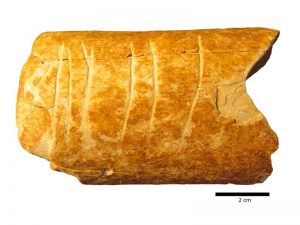
Michal Brener, longstanding friend and supporter of UofH, is awarded the Carmel Award of Merit
In the News Michal Brener, founder of the Gan Hayeled Center, was honored with the University’s Carmel Award of Merit. Mrs. Brener was recognized for

Researchers from the University of Haifa, the Hebrew University and the French National Center for Scientific Research identified six subparallel incisions on a bone fragment found at a Middle Paleolithic site near the city of Ramle. Dating back 120,000 years ago, the fragment represents one of the oldest pieces of evidence of the use of symbols. Dr Iris Groman-Yaroslavski (Zinman Institute of Archaeology) explained, “Based on our laboratory analysis and discovery of microscopic elements, we were able to surmise that people in prehistoric times used a sharp tool fashioned from flint rock to make the engravings.” READ MORE in Smithsonian, i24news, the Jerusalem Post and the Daily Mail
**The bone featuring the world’s oldest symbols by a right-handed craftsperson. | Credit: Marion Prévost

In the News Michal Brener, founder of the Gan Hayeled Center, was honored with the University’s Carmel Award of Merit. Mrs. Brener was recognized for

This year’s European Research Night was held online for the first time. The UofH virtual booth showcased a broad mix of research topics through open

In the News The University community warmly welcomes seasoned Jewish leader Naomi Reinharz as the new Chief Executive Officer of the American Society of the
© University of Haifa Division of External Relations